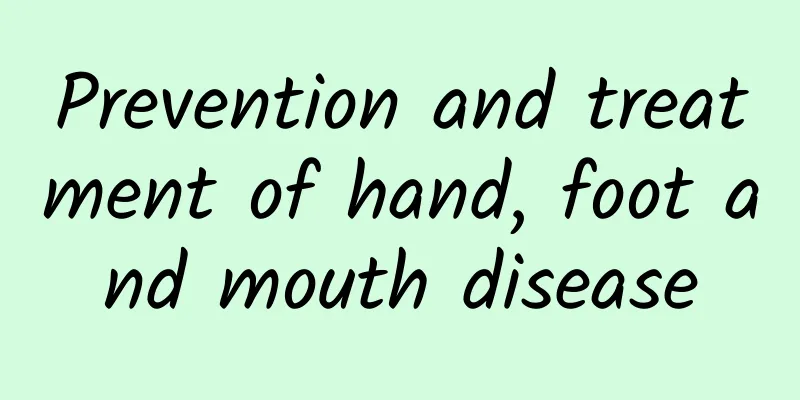Prevention and treatment of hand, foot and mouth disease

|
Prevention and treatment of hand, foot and mouth disease 1. Pathogen and epidemiology Hand, foot and mouth disease (HFMD) is an infectious disease caused by enterovirus. There are more than 20 types of enterovirus that cause HFMD. Among them, Coxsackievirus A16 (CoxA16) and enterovirus 71 (EV-71) are the most common. EV-71 is highly infective to the central nervous system. HFMD can occur in all seasons, with the highest incidence in summer and autumn. People are generally susceptible to it, and it is more common in children, especially those under 3 years old. Humans are the only known host of human enterovirus. It is mainly transmitted through the digestive tract, respiratory tract, contact with the patient's respiratory secretions, herpes fluid and contaminated objects. A few days before the onset of the disease, the virus can be detected in the pharyngeal secretions and feces of the infected person, and the virus can be excreted in the feces for up to 3-5 weeks. It is most contagious within 1 week after the onset of the disease. Both patients and latently infected people are sources of infection. The incubation period is 2-7 days, and the onset is often acute. Common symptoms include fever, pharyngeal discomfort, loss of appetite, and non-specific infection symptoms such as runny nose, cough, nausea, vomiting, and headache. The skin diagnosis is first maculopapular, and then turns into herpes. There is a small amount of fluid in the blisters. The rash is round or quasi-circular, about 3-7mm in size. The rash is centrifugal, mainly located in the mouth, hands, feet, and buttocks. Patients should be isolated for at least 2 weeks, and close contacts should be quarantined for at least 10 days. After infection, people can produce specific antibodies and gain immunity, but there is no cross-immunity between different types of viruses. 2. Clinical manifestations 1. Common cases Generally, the symptoms are mild, and the process is self-limited for those without complications. Most patients recover within a week, and the prognosis is good. Only intensive care and symptomatic treatment are needed. 2. Severe cases In a few cases, the disease progresses rapidly, and serious or even fatal complications such as brain, lung, and heart may appear within 1-5 days of onset, which must be taken seriously clinically. (1) Symptoms and signs of the nervous system may occur due to complications of meningitis, encephalitis, and encephalomyelitis. (2) Respiratory symptoms and signs occur due to concurrent pulmonary edema. (3) Symptoms and signs of the circulatory system due to concurrent circulatory disorders. 3. Laboratory Examination Depending on the specific conditions of the patient's condition, relevant examinations such as routine blood tests, blood biochemistry, blood gas analysis, cerebrospinal fluid, etiology, serology, chest X-ray, and magnetic resonance imaging can be performed selectively. 4. Diagnosis and differential diagnosis The diagnosis is not difficult based on the epidemiological history, age of onset, site of skin examination and laboratory tests. In addition to differential diagnosis from varicella, clinically, it is also necessary to make differential diagnosis from the following diseases: 1. Other rash diseases. 2. Encephalitis or meningitis caused by other viruses. 3. Pneumonia. 4. Fulminant myocarditis, etc. 5. Treatment (must be carried out under the guidance of a professional doctor). 1. Common cases There is no effective antiviral drug or specific treatment method at present, and the treatment is mainly symptomatic. Pay attention to isolation to avoid cross infection. Strengthen care, eat a light diet, and get adequate rest. 2. Severe cases Symptomatic treatment should be given according to the actual situation of the patient, and glucocorticoids and immunoglobulins should be used as appropriate. 6. Prevention 1. Patients must be isolated for treatment to avoid cross infection for at least 2 weeks. The patient's secretions, excretions, and items that have been in contact with the patient must be disinfected. Confirmed cases must fill out the infectious disease report card and report it immediately according to regulations. 2. Close contacts must be quarantined for at least 10 days and receive passive immunization through intramuscular injection of immunoglobulin. 3. Carry out scientific education for the general public to increase awareness of disease prevention and reduce the chance of illness. During the epidemic, do not go to public places where people gather, wear masks, pay attention to personal and environmental hygiene, ventilate the home frequently, dry clothes and quilts frequently, wash hands frequently, strengthen food hygiene, and do not eat (drink) raw or cold food. 4. Strengthen nutrition and physical exercise. 5. Nursery institutions and schools should strengthen morning inspections and isolate and treat suspected patients in a timely manner. Strictly control the return of sick children to schools and kindergartens. Isolation treatment should not be less than 2 weeks. |
<<: What to eat when you are sick? This most frequently asked question has an answer today!
>>: Don't let the disease take away your memory! Learn about these facts about Alzheimer's disease
Recommend
How to quickly catch wheat ears when fishing in the wild and how to make the wheat ears delicious
The name of the wheatear fish varies in different...
Can Hoya be propagated by cuttings? How can Hoya be propagated by cuttings to achieve a high survival rate?
Hoya is a common flower plant in life. Due to its...
What should you do when thyroid nodules are "harmful" to you?
Author: Yang Xiaorong Shanghai Pudong New Area Zh...
Pregnant women eczema pictures
I heard that eczema in pregnant women can be cont...
Causes of pelvic pain in pregnancy
Pelvic pain in pregnant women may be caused by th...
What to do with vaginal pain? Do you know these methods?
The vagina is a particularly private and sensitiv...
The harm of women not eating breakfast_The harm of girls not eating breakfast
Many women are unwilling to eat breakfast in orde...
[Exclusive Interview with Min Weijie] With 3.4 million new strokes occurring in my country each year, how dangerous is stroke?
Introduction: Stroke is a very common disease in ...
Can you really tell the difference between renal cysts and polycystic kidney disease?
Although both renal cysts and polycystic kidney d...
Best time for women to conceive
As the Chinese say, there are three types of unfi...
What if the menstrual blood is black and has a strange smell?
Menstruation occurs once a month in women, so it ...
When does a girl ovulate?
Basically every girl needs to go through menstrua...
What are the benefits of rose tea for the body? Is it better to have a big rose tea or a small one?
Roses contain many substances that are beneficial...
Is it good to store white tea for a long time? How to store white tea yourself
White tea is one of the five major types of tea i...









